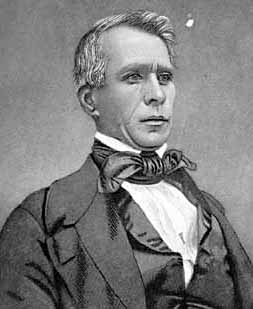Wilson Shannon facts for kids
Quick facts for kids
Wilson Shannon
|
|
|---|---|
 |
|
| 2nd Territorial Governor of Kansas | |
| In office September 7, 1855 – August 18, 1856 |
|
| Preceded by | Andrew Reeder |
| Succeeded by | John W. Geary |
| 14th and 16th Governor of Ohio | |
| In office December 13, 1838 – December 16, 1840 |
|
| Preceded by | Joseph Vance |
| Succeeded by | Thomas Corwin |
| In office December 14, 1842 – April 15, 1844 |
|
| Preceded by | Thomas Corwin |
| Succeeded by | Thomas W. Bartley |
| Member of the U.S. House of Representatives from Ohio's 17th district |
|
| In office March 4, 1853 – March 3, 1855 |
|
| Preceded by | Joseph Cable |
| Succeeded by | Charles J. Albright |
| Personal details | |
| Born | February 24, 1802 Belmont County, Northwest Territory |
| Died | August 30, 1877 (aged 75) Lawrence, Kansas |
| Resting place | Oak Hill Cemetery |
| Political party | Democratic |
| Spouses | Elizabeth Ellis, Sarah Osbun |
| Alma mater | Ohio University Transylvania University |
| Profession | attorney, politician |
Wilson Shannon (born February 24, 1802 – died August 30, 1877) was a Democrat who became a politician. He served as the 14th and 16th governor of Ohio. He was the first Ohio governor who was actually born in that state. Later, he became the second governor of the Kansas Territory.
Contents
Early Life and Family
Wilson Shannon was born in Belmont County, which was part of the Northwest Territory at the time. His father, George Shannon, was an Irish immigrant who fought in the Revolutionary War.
Wilson had two older brothers who were also notable. His brother, Thomas Shannon, served in the United States House of Representatives. His oldest brother, George Shannon, was the youngest person on the famous Lewis and Clark Expedition.
Political Career in Ohio
Wilson Shannon studied at Ohio University, Franklin College, and Transylvania University. After his studies, he became a lawyer in 1830. From 1833 to 1835, he worked as a prosecuting attorney for Belmont County. This meant he represented the government in court cases.
Shannon first tried to get elected to the U.S. House of Representatives in 1832 but lost by a very small number of votes. He then won the election for governor of Ohio in 1838. He lost his re-election in 1840 to Thomas Corwin, a member of the Whig Party. However, Shannon defeated Corwin two years later to win a second term as governor.
In 1844, President John Tyler chose Shannon to be the Minister to Mexico. This was like being an ambassador. Shannon resigned from his governor role on April 15, 1844, to take this new job. He stayed in Mexico for about a year before returning home.
After his time in Mexico, Shannon went to California during the 1849 gold rush. He later returned to politics and was elected to the U.S. House of Representatives in 1852. He served one term there.
Governor of Kansas Territory
In 1855, President Franklin Pierce appointed Wilson Shannon as the Governor of the Kansas Territory. He officially started his job on September 7, 1855.
During his time as governor, Kansas was a very difficult place. There was a lot of fighting between people who wanted Kansas to allow slavery and those who wanted it to be a free state. This period is often called "Bleeding Kansas" because of the violence.
Shannon was known for supporting the Southern view on slavery. He often used federal troops to try and bring peace to the territory. However, he faced many challenges and political problems.
Key Events During His Term
In May 1856, a large group of people who supported slavery attacked Lawrence. They destroyed many buildings and printing presses in an event known as the "Sacking of Lawrence." Governor Shannon did not stop this attack, which made many people upset.
In response to the attack on Lawrence, John Brown and a small group of his followers killed five settlers who supported slavery. This event, called the "Pottawatomie massacre", led to even more violence in Kansas.
Shannon found it very hard to control the territory. He left Kansas for St. Louis on June 23, 1856, leaving Daniel Woodson in charge. Shannon offered his resignation to President Pierce on August 18, 1856. However, the President had already decided to remove him from office.
Shannon feared for his safety and moved back east. He met John Geary, who would become the next territorial governor, on September 7 in Glasgow, Missouri.
Even though his time as governor of Kansas was full of problems, Wilson Shannon served the longest continuous term of any Kansas territorial governor. He was in office for more than nine and a half months out of an eleven-month term.
Later Life and Legacy
After leaving his role as governor, Shannon returned to Kansas. He started a law practice in Lecompton, and later in Lawrence and Topeka. He often told visitors how hard it was to govern Kansas during that time.
Wilson Shannon passed away in Lawrence on August 30, 1877. He is buried in Oak Hill Cemetery in Lawrence.
The town of Shannon, Kansas, which was the first county seat of Anderson County, was named after him. However, this town no longer exists; it ceased to exist in 1860.
See also
- Shannon Political Family

